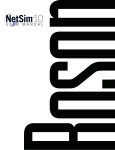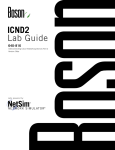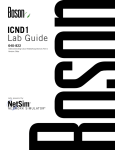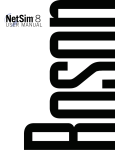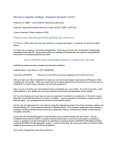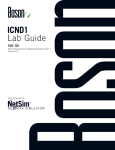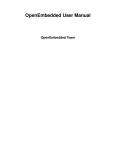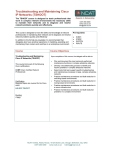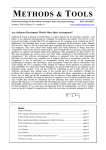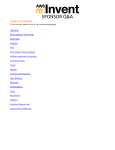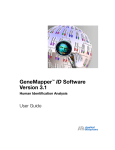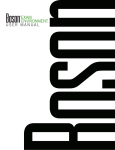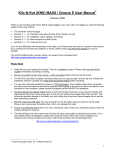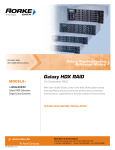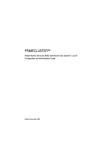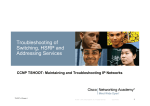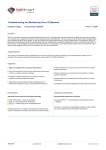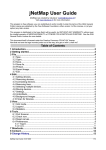Download NetSim 9 User Manual
Transcript
9 User Manual 9K214A Table of Contents Boson NetSim Overview.............................................................................................................................1 Using NetSim to Prepare for Your Certification.......................................................................................3 Contact Information.................................................................................................................................4 NetSim Technical Support.......................................................................................................................4 License Solutions....................................................................................................................................4 Getting Started.............................................................................................................................................5 System Requirements.............................................................................................................................5 Product Activation...................................................................................................................................5 Demo Version...................................................................................................................................6 Full Version.......................................................................................................................................6 Begin a Lab..................................................................................................................................................7 Menus...........................................................................................................................................................8 Menu Bar................................................................................................................................................8 File Menu..........................................................................................................................................8 New............................................................................................................................................8 Open..........................................................................................................................................8 Save...........................................................................................................................................8 Save As......................................................................................................................................8 Save All......................................................................................................................................8 Package Lab..............................................................................................................................8 Import.........................................................................................................................................8 Export.........................................................................................................................................8 Recent Saved Topologies..........................................................................................................9 Recent Saved Labs....................................................................................................................9 Recent Loaded Labs..................................................................................................................9 Exit.............................................................................................................................................9 Edit Menu.........................................................................................................................................9 Proxy Settings............................................................................................................................9 Preferences................................................................................................................................9 View Menu........................................................................................................................................9 Current Mode.............................................................................................................................9 Current View............................................................................................................................10 Toolbar.....................................................................................................................................10 Status Bar................................................................................................................................10 Auto Collapse Tree..................................................................................................................10 Auto Hide Menu.......................................................................................................................10 Lab Menu........................................................................................................................................10 Boson NetSim User Manual Load Lab .................................................................................................................................10 Grade Lab................................................................................................................................10 Launch External Lab Viewer....................................................................................................10 Launch External NetMap Viewer..............................................................................................10 Paste Router Configuration...................................................................................................... 11 Open All Devices...................................................................................................................... 11 Designer Menu............................................................................................................................... 11 New Topology........................................................................................................................... 11 Clear NetMap........................................................................................................................... 11 Add........................................................................................................................................... 11 Compiler Menu............................................................................................................................... 11 New.......................................................................................................................................... 11 Edit........................................................................................................................................... 11 Delete.......................................................................................................................................12 Wizard......................................................................................................................................12 Help Menu......................................................................................................................................12 Users Manual...........................................................................................................................12 Support....................................................................................................................................12 Activate Keys...........................................................................................................................12 Check for Updates...................................................................................................................12 About Boson NetSim................................................................................................................12 Quick-Launch Toolbar...........................................................................................................................12 New Topology.................................................................................................................................12 Open File........................................................................................................................................12 Save...............................................................................................................................................12 Save All...........................................................................................................................................12 Grade Lab.......................................................................................................................................13 Console to Device..........................................................................................................................13 Zoom In..........................................................................................................................................13 Zoom Out........................................................................................................................................13 Add New Device.............................................................................................................................13 Add New Connection......................................................................................................................13 Delete Selected..............................................................................................................................13 Clear Topology................................................................................................................................13 Start Simulator................................................................................................................................13 Stop Simulator................................................................................................................................13 Launch Lab Compiler Wizard.........................................................................................................13 ii Boson NetSim User Manual Move Selection Up.........................................................................................................................14 Move Selection Down.....................................................................................................................14 Check for Updates..........................................................................................................................14 Edit Application Preferences...........................................................................................................14 Open User Manual.........................................................................................................................14 Exit Boson NetSim..........................................................................................................................14 Navigation..................................................................................................................................................15 Home....................................................................................................................................................15 Saved Files.....................................................................................................................................15 Welcome.........................................................................................................................................15 News...............................................................................................................................................16 Labs......................................................................................................................................................16 Lab Navigation................................................................................................................................17 Standard Tab............................................................................................................................17 Search Labs......................................................................................................................17 Available Labs...................................................................................................................17 Lab Description..................................................................................................................17 Custom Tab..............................................................................................................................17 Search Labs......................................................................................................................17 Available Labs...................................................................................................................18 Lab Description..................................................................................................................18 Lab Instructions / NetMap Section..................................................................................................18 Lab Instructions Tab.................................................................................................................18 NetMap Tab..............................................................................................................................19 Consoles Section............................................................................................................................19 Console Window......................................................................................................................20 Settings Button.........................................................................................................................20 SDM Button..............................................................................................................................20 Network Designer.................................................................................................................................20 Creating a New Topology.........................................................................................................21 Add Devices......................................................................................................................22 Add Connections...............................................................................................................25 Device Statistics.......................................................................................................................29 Save.........................................................................................................................................29 Lab Compiler.........................................................................................................................................30 Compiling a Lab..............................................................................................................................31 XPS File...................................................................................................................................31 iii Boson NetSim User Manual BSN Topology File....................................................................................................................31 BSN Loading Configuration File...............................................................................................31 BSN Completed Configuration File..........................................................................................31 Creating a Custom Lab Pack..........................................................................................................32 Using the Lab Compiler Wizard to Create a Lab Pack ........................................................... 32 Manually Creating a Lab Pack.................................................................................................32 Adding a Section to a Lab Pack........................................................................................33 Adding a Lab to a Lab Pack Section.................................................................................33 Troubleshooting........................................................................................................................................35 Some of my labs have locks next to them, and I can’t work through them........................................... 35 Commands seem to disappear when I press the Enter key on the number pad in Telnet mode.......... 35 Telnet is not working on my Windows 8, Windows 7, or Windows Vista computer............................... 35 The Custom tab is empty......................................................................................................................35 iv Boson NetSim User Manual Boson NetSim Overview The Boson NetSim® Network Simulator®, which includes the Boson Router Simulator®, is unique compared to all others on the market because of the functionality it supports and its features. NetSim utilizes Boson’s proprietary Network Simulator, Router Simulator®, and EROUTER® software technologies, along with the Boson Virtual Packet Technology® engine, to create individual packets. These packets are routed and switched through the simulated network, allowing NetSim to build an appropriate virtual routing table and simulate true networking. Other simulation products on the market do not support this level of functionality. NetSim is a Windows®-based product that simulates a wide variety of Cisco® routers, including the 2500 series, 2600 series, 2800 series, and 3600 series routers, as well as the Cisco Catalyst 1900 series, 2900 series, and 3500 series switches. NetSim supports multiple routing protocols, including RIP, IGRP, EIGRP, BGP, and OSPF. It supports different LAN/WAN protocols, including PPP/CHAP, ISDN, and Frame Relay. The labs in NetSim require only the devices and functionality included with NetSim—they do not require access to any external router or switch hardware. NetSim supports many, but not all, of the IOS commands available on a physical router or switch. All of the commands referenced in the available labs are supported by NetSim. Achieving Cisco CCENT®, CCNA®, or CCNP® certification is the goal of many people who use this product. The Boson NetSim covers not only the SWITCH (642-813), TSHOOT (642-832), and ROUTE (642-902) certifications but also the ICND1 (new: 100-101; old: 640-822), ICND2 (new: 200-101; old: 640816), and CCNA (new: 200-120; old: 640-802) certifications, among others. The included labs guide you through the configuration of routers, switches, and workstations in a variety of scenarios. Installed labs are made available (unlocked) depending on the activation key used to activate the product. All labs are downloaded and kept up to date after installation regardless of the activation key used; however, the only labs that are available are ones that have been unlocked with the associated activation keys. Activation keys unlock labs and increase the number of available commands. Beginning with the Demo version of NetSim 9, the command set is limited to those necessary to perform the steps in the lab. For example, if you start your studies with a CCENT activation key, you will have the command set and labs available that are necessary to study for that exam. When you are ready to study for either the CCNA or CCNP exam, you will need to purchase a new activation key and activate NetSim with the new CCNA or CCNP activation key; then, more labs and a larger command set become available. Some of the labs available in the Sequential lab pack when a CCENT activation key has been used to activate NetSim 9 are shown in the following graphic. A CCENT activation key also unlocks a selection of labs from the Stand-Alone and Scenario lab packs. A small lock icon ( ) is displayed next to unavailable labs. Higher-level activation keys allow you to work through all labs unlocked by lower-level activation keys. All demo, CCENT, CCNA, and CCNP labs are unlocked when a CCNP-level activation key is used. Some lab packs are delivered by NetSim to support other products that are sold separately. If you have questions about locked labs, please contact [email protected]. Boson NetSim User Manual After you load and complete an unlocked lab, you can use the grading function in NetSim to grade the lab so that you can determine whether you completed it correctly. As you progress through the labs, you will master the skills needed to pass the simulation questions in the Cisco certification exams. NetSim has the ability to guide and grade, and using it for practice can be more helpful than using real routers and switches. NetSim allows you to gain experience without requiring you to purchase expensive equipment. You can use the Boson NetSim to work through labs, but you can also use it for additional purposes. The included full version of the Network Designer tool allows you to practice designing and planning a network. This tool’s functionality goes beyond that of most tools because you can actually create the router configurations that are going to be used, save those configurations, and practice using them on simulated devices. Routing protocol implementation is one of the more challenging tasks you may encounter. Troubleshooting a production network can be a frustrating experience. Fortunately, you can create a virtual copy of your network topology by using the Boson Network Designer and troubleshoot the problems without interfering with your production network. Because NetSim is designed as a study tool for Cisco certification, you should not rely only on NetSim to make decisions about a production network, but you may find it useful in your troubleshooting efforts. Boson NetSim User Manual In summary, Boson NetSim is a flexible and powerful product that can help you become certified and, in some cases, can be used to create a simulation of the topology of your corporate network and help you practice troubleshooting without using devices on the production network. Using NetSim to Prepare for Your Certification By using NetSim to help you achieve a Cisco certification, you can learn and master the skills necessary to help you successfully complete your certification track. The purpose of NetSim is to help you with the practical, hands-on portion of your education and to ensure that you not only understand the concepts of routing but can actually configure and implement routing on Cisco devices. Mastering Cisco networking involves two fundamental tasks: 1. Learn the theory of routers and switches. 2. Gain the hands-on experience of implementing that theory by configuring the devices in a network and testing them in a lab. Self-studying for a Cisco certification can be a daunting task. The amount of information a CCNA candidate is required to know and the skills that candidate is required to possess are quite extensive. To begin learning the theory of configuring a network, you can find a good reference book or listen to an instructor. (Boson Training, www.boson.com/boson-training, offers a full slate of classes and bootcamps.) But a reference book might not be enough. The book will not give you the practical, hands-on experience of routing and switching that you can learn from NetSim—experience that will help you build on the theoretical knowledge you learned from the reference book. Real equipment gives you the ability to practice on physical routers and switches, but it also is a very costly way to practice and leaves a lot of room for error. The Boson NetSim, on the other hand, is an excellent tool to help you prepare for the CCNA (www.boson.com/certification/CCNA) and CCNP (www. boson.com/certification/CCNP) exams. NetSim simulates the behavior of a network and does not just return preprogrammed responses to expected command inputs. It allows you to create virtual packets and virtual frames that will be routed and switched through the simulated network. Aside from physically plugging in the cables and listening to the fan noise, your experience with the simulated network will be much the same as your experience with a fully functional lab rack without the expense of the hardware. NetSim will enable you to practice various configurations and master helpful skills. Once you feel you have mastered both the theory (www.boson.com/boson-training) and the practical labs (www.boson.com/netsim-cisco-network-simulator), you can test your knowledge by using the Boson ExSim-Max practice exam products available at the ExSim-Max home page (www.boson.com/exsim-maxpractice-exams). Boson ExSim-Max products include complex multiple-choice questions, drag-and-drop questions, Boson NetSimX simulation questions, and trouble tickets. The Boson NetSim Network Simulator is the most comprehensive product on the market for learning how to configure a Cisco router. The Boson NetSim will not only help you become certified, it will help you learn and understand how to configure routers, switches, and networks. Boson NetSim User Manual Contact Information EMAIL: [email protected] PHONE: 877-333-EXAM (3926) 615-889-0121 FAX: 615-889-0122 ADDRESS: 25 Century Blvd. Ste. 500 Nashville, TN 37214 Copyright © 1996 - 2014 Boson Software, LLC. All rights reserved. NetSim software and documentation are protected by copyright law. NetSim Technical Support • To review NetSim support topics, go to the NetSim Products Support Topics page (www.boson.com/ support/netsim-support-topics). • To submit a support ticket, go to Boson’s Web site (www.boson.com) > log in to your account > click the Support Tickets tab > start a new ticket. License Solutions • Single-User License Agreement (SULA) – You can review the SULA here (www.boson.com/SULA). • License Server – For our unique license-server solutions and volume discounts, contact us at www. boson.com, 877.333.EXAM or [email protected]. Boson NetSim User Manual Getting Started System Requirements • Supported Operating Systems: Windows 8, Windows 7, Windows Vista, Windows XP • .NET Framework: Microsoft .NET Framework Version 4.0 • Processor: 1-GHz Pentium processor or equivalent (Minimum); 3-GHz Pentium processor or equivalent (Recommended) • RAM: 512 MB (Minimum); 2 GB (Recommended) • Hard Disk: Up to 100 MB of available space • Display: 1024 x 768, 256 colors (Minimum); 1024 x 768 high color, 32-bit (Recommended) • Active Internet connection Product Activation You must have a Boson account to download the NetSim Demo. To create a free account, visit the Boson Online Account page (https://www.boson.com/Account/Default.aspx) and enter a valid e-mail address to begin creating an account. You can open NetSim from the shortcut installed during the download or from the Start menu by clicking Boson Software > Boson NetSim 9.0 > Boson NetSim. If you are a student using NetSim 9 at a learning institution, you should launch NetSim 9 from the Start menu by clicking Boson Software > Boson NetSim 9.0 > Boson NetSim LS Client. This will enable you to configure NetSim 9 to authenticate with the Boson NetSim License Server. When you first open NetSim, you will be presented with the NetSim Activation Wizard dialog box. You can select the demo version of NetSim or the full version of NetSim. Boson NetSim User Manual Demo Version Demo mode launches NetSim with limited commands for evaluation purposes. You will be asked to select how you are connected to the Internet. If you are using a proxy server, you must configure the appropriate settings. When prompted, enter the e-mail address and password associated with your Boson.com account. If you have not previously created a Boson.com account, you can create one through the NetSim Activation Wizard. Within the demo version of NetSim, only a few labs and commands are available. If you would like to access additional labs and commands, you must activate a full version of the Boson NetSim. If you have not purchased an activation key for NetSim, you will not be able to activate the full version of NetSim. However, you can choose to continue in Demo mode. When you are running the Demo version, only the demo labs and a limited set of commands are functional. To purchase the full version of NetSim, visit the About NetSim page (www.boson.com/netsim-cisco-network-simulator) of our Web site. Full Version To activate a full version of NetSim, you should select the I want to activate NetSim option from the NetSim Activation Wizard dialog box and click Next. When prompted, enter the e-mail address and password associated with your Boson.com account. If you have not previously created a Boson.com account, you can create one from the Boson Online Account page (https://www.boson.com/Account/ Default.aspx). Boson NetSim User Manual You will then be required to enter your activation key(s) to activate NetSim and to unlock the lab packs you purchased. After entering your activation key(s), click Activate. The activation key(s) should be in the purchase receipt you received via e-mail, or you can find the receipt online on your Boson Online Account page (https://www.boson.com/Account/Default.aspx). To activate a full version of NetSim online, you must have an active Internet connection; if you do not have an active Internet connection, you can use manual activation to activate offline. If you have previously activated NetSim with another key and would like to see that key, you can clear the Hide previously activated NetSim keys option; the Hide option is enabled by default. Additionally, if you have multiple keys that you would like to use to activate NetSim, you can click the Add Field button to add fields to the dialog box. If you open NetSim and are not prompted to activate, either because you previously used the demo version or because you activated with a different activation key, you can click Help > Activate Keys to open the Activate Keys dialog box. You can click the Credentials button to verify that the associated account is your Boson.com account. If necessary, click Close to proceed to the full version of NetSim. After a successful activation, the lab packs will be updated and NetSim will be ready for you to use. Installed labs are made available (unlocked) depending on the activation key used to activate the product. A small lock icon ( ) is displayed next to unavailable labs. To make locked labs available, you will need to purchase and enter the new activation key; then, more labs and a larger command set become available. Begin a Lab To begin a preloaded Boson NetSim lab, perform the following steps: 1. On the navigation pane, click Labs. 2. On the Standard tab, double-click the lab you want to open. 3. After you have loaded a lab, click the Lab Instructions tab and read through the lab instructions. Boson NetSim User Manual 4. From the Devices drop-down menu in the Consoles section, select the device(s) that you need to configure in order to complete the lab and follow the steps in the lab. 5. When you have completed the lab, click the Grade Lab icon ( have completed the lab successfully. ) on the toolbar to ensure that you 6. You can choose to save your configurations by selecting the appropriate Save option from the File menu. There is more information about saving device configurations in the Network Designer section or the Quick-Launch Toolbar section of this manual. Menus The menu options in NetSim 9 enable you to easily navigate through the labs, the NetMap and Network Designer, the Lab Compiler, the Consoles section, and more. These menus include the Menu Bar and the Quick-Launch Toolbar. Menu Bar File Menu The options in this menu tree enable you to open configuration files, open topology files, save configuration files, save topology files, import and export labs, and exit the program. New This option opens a new topology in the Network Designer. Open This option enables you to select a file to open. The supported file extensions are *.lab and *.bsn. Save This option enables you to save your current lab or topology and configurations. Files are saved with the *.lab or *.bsn extension. Save As This option enables you to save your current lab or topology and configurations. Files are saved with the *.lab or *.bsn extension. Save All This option enables you to save all unsaved lab, topology, and/or configurations that are currently open. Files are saved with the *.lab or *.bsn extension. Package Lab This option is primarily for License Server users and enables those users to save the current lab. This option adds user data so that instructors know who submitted the labs. Import This option imports a previously saved lab, a previously saved lab pack, network configurations, or legacy NetSim files. Export This option exports a lab or lab pack created with the Lab Compiler or the network configurations currently running in the simulator. Boson NetSim User Manual Recent Saved Topologies If you recently saved a topology, it will appear in this list. You can click a file to open it. Recent Saved Labs If you recently saved a lab, it will appear in this list. You can click a file to open it. Recent Loaded Labs If you recently loaded a lab, it will appear in this list. You can click a file to open it. Exit This option closes the program. Edit Menu The options in this menu tree enable you to configure proxy settings and change your preferences. Proxy Settings This option enables you to configure proxy settings for an Internet connection. Preferences This option opens the Preferences dialog box, from which you can configure the appearance of NetSim, the user experience (including the layout and dialogs), and the proxy settings. You can also configure the lab to load with the instructions in a separate window (see more information in the Lab Instructions Tab section), and you can configure the lab to load with a tab open for all devices in the associated topology (see more information in the Lab Menu section). This also enables you to restore program defaults. View Menu The options in this menu tree enable you to alter the way you view the panels within NetSim. Current Mode This option enables you to select the way you view the consoles of the devices you are configuring in a lab. In Window mode, each device is accessible on the Consoles section of the Labs panel. In Telnet mode, each device is accessible through a separate Telnet window for each device. Boson NetSim User Manual Current View This option enables you to switch among the options on the navigation pane: Home, Labs, Network Designer, and Lab Compiler. Toolbar Clear this option to hide the Quick-Launch toolbar. Select this option to restore the Quick-Launch toolbar. Status Bar Clear this option to hide the status bar at the bottom of the screen. Select this option to restore the status bar. Auto Collapse Tree Clear this option to expand all options in the lab menu. Select this option to collapse all options in the lab menu. Auto Hide Menu When this option is enabled, press the tilde key (~) to hide or display the Menu Bar. To disable the auto hide functionality, clear this option. Lab Menu This menu tree enables you to perform all the functions you need once a lab is loaded. Load Lab After you select a lab from the navigation pane, click this option to load the lab instructions, topology, and configurations. Grade Lab After you have completed a lab, click this option to verify that you have completed the lab successfully. Launch External Lab Viewer Click this option to open the lab instructions in a new window. You can then move the instructions to a second monitor or place them beside, above, or below the original NetSim window. This feature provides multimonitor support so that you can view the lab document on one monitor while entering commands on a second monitor. Launch External NetMap Viewer Click this option to open the NetMap in a new window. You can then move the NetMap to a second monitor or place the NetMap, which displays the topology, beside, above, or below the original NetSim window. This feature provides multimonitor support so that you can maximize the use of your computer real estate and easily view the topology on one monitor while entering commands on a second monitor. 10 Boson NetSim User Manual Paste Router Configuration This option allows you to paste the running configuration from a real router into a device in NetSim. Selecting this menu option will open a dialog box into which you can paste or type the desired configuration. The configuration will be loaded into the active device in the NetSim interface. Open All Devices Click this option to open a tab in the Consoles section for every device in the network of the currently loaded topology. You can selectively close individual devices by clicking the close icon ( ). Designer Menu The options in this menu enable you to create a new topology and modify existing ones. You can add devices and connections to the topology in Network Designer, and you can also click and drag the devices to rearrange your simulated network. New Topology This option enables you to begin designing a new topology. Clear NetMap This option enables you to clear the topology you are creating. You will be asked to confirm that you want to clear the topology. Add This option enables you to add devices and connections to your topology. Clicking Add > Device will open the Add Device dialog box, from which you can choose the device you want to add. Clicking Add > Connection after you have added at least two devices and selected one on the topology will open the New Connection dialog box, from which you can choose the connection type and interfaces. Compiler Menu The options in this menu tree enable you to create a new lab pack for personal or instructional use. New This option enables you to select a new custom lab pack, a new lab, or a new section. To view the new lab pack, click the Lab Compiler button. More information can be found in the Compiling a Lab section of this manual. Edit This option enables you to edit the title of previously created custom sections or lab packs and enables you to edit previously created custom labs. 11 Boson NetSim User Manual Delete This option deletes the selected lab pack, section, or lab. You will be asked to confirm that you want to delete the selected component. Wizard This option launches the Lab Compiler Wizard, which enables you to easily compile a lab pack for personal or instructional use. Help Menu The options in this menu tree enable you to find out more information about the Boson NetSim Network Simulator and how to find support if you need it. Users Manual This option opens the Boson NetSim User Manual, the document you are reading now, which guides you through the features and functionalities of NetSim. Support This option displays frequently asked questions (FAQs) on the Boson NetSim support page (www. boson.com/support/netsim-support-topics), allows you to save your current log files in the *.zip format, and allows you to submit a ticket through your Boson.com account. Activate Keys This option opens the Activate Keys dialog box. From here, you can activate additional versions of NetSim and the associated labs. Check for Updates This option closes NetSim and downloads any available updates. About Boson NetSim This option displays basic information about NetSim, including the version and company information. Quick-Launch Toolbar Icons in the Quick-Launch toolbar are enabled or disabled depending on the pane in use. New Topology Click the New Topology icon ( ) to open the Network Designer and begin creating a topology. Open File Click the Open File icon ( ) to open a supported file. Supported file types are *.lab and *.bsn. Save Click the Save icon ( ) to save your current lab progress (*.lab) or configurations and topology (*.bsn). Save All Click the Save All icon ( ) to save all changes, including changes to devices in the Network Designer and changes to their configurations. 12 Boson NetSim User Manual Grade Lab Click the Grade Lab icon ( ) to grade the currently loaded lab. Console to Device ) to open a device from the NetMap in the Consoles section. Click the Console to Device icon ( Zoom In Click the Zoom In icon ( Network Designer. ) to increase the size of devices on the NetMap or on the active topology in Zoom Out Click the Zoom Out icon ( Network Designer. ) to decrease the size of devices on the NetMap or on the active topology in Add New Device Click the Add New Device icon ( Designer. ) to add a new device to the to the active topology in Network Add New Connection Click the Add New Connection icon ( topology in Network Designer. ) to add a new connection between two devices on the active Delete Selected Click the Delete Selected icon ( Designer. ) to delete a selected device from the active topology in Network Clear Topology Click the Clear Topology icon ( Network Designer. ) to delete all devices and connections from the active topology in Start Simulator Click the Start Simulator icon ( ) to load the active topology into the simulator, open the Consoles section, and begin configuring device. This option is disabled in Demo mode and in labs that are included in NetSim. Stop Simulator Click the Stop Simulator icon ( ) to stop the simulator and to reopen Network Designer, where you can reconfigure the devices and connections. This option is disabled in Demo mode and in labs that are included in NetSim. Launch Lab Compiler Wizard Click the Launch Lab Compiler Wizard icon ( 13 ) to launch the Lab Compiler Wizard. Boson NetSim User Manual Move Selection Up Click the Move Selection Up icon ( the Lab Tree. ) to move the selected lab pack, lab section, or lab up a position in Move Selection Down Click the Move Selection Down icon ( position in the Lab Tree. ) to move the selected lab pack, lab section, or lab down a Check for Updates Click the Check for Updates icon ( ) to force Boson NetSim to check for updates. Edit Application Preferences Click the Edit Application Preferences icon ( experience. ) to configure preferences such as appearance and user Open User Manual Click the Open User Manual icon ( you are currently reading. ) to view the Boson NetSim 9 User Manual, which is the document Exit Boson NetSim Click the Exit Boson NetSim icon ( 14 ) to exit Boson NetSim. Boson NetSim User Manual Navigation Home You can open the Home panel by clicking Home on the navigation pane. There are many components of this panel and various features that you can access from this panel. After NetSim loads, you can perform various tasks by clicking the name of a recently loaded topology or lab, selecting a quick option such as checking for updates or opening the NetSim 9 User Manual (this document), or accessing a different panel by clicking Labs, Network Designer, or Lab Compiler. The Home panel is shown below: Saved Files From this section, you can quickly load a saved topology, saved lab, or recent lab. Welcome From this, the largest section, you can load a lab, create a new topology, compile a custom lab, and more. 15 Boson NetSim User Manual News This section displays updates and special offers from the Boson Web site (www.boson.com). You can scroll through this section to see the latest news and information, and you can click more to view the related offer on the Web site. If you are not connected to the Internet, you might not see any news in this section. To see the latest news from Boson, make sure that you are connected to the Internet. Labs You can open the Labs panel by clicking Labs on the navigation pane. This panel contains three sections: the Lab Navigation section, the Lab Instructions / NetMap section, and the Consoles section. You can click and drag the splitter control between the Lab Instructions / NetMap section and the Consoles section to increase or decrease the size of those sections. 16 Boson NetSim User Manual Lab Navigation Standard Tab There are three main sections on this tab: Search Labs, Available Labs, and Lab Description. Search Labs You can use the Search Labs section to search for a specific term within a lab description. You can search throughout all the available labs. For example, if you want to test your Network Address Translation (NAT) skills on labs dealing with NAT, you could type nat in the search box and press the Enter key. You will see labs addressing NAT from the Stand-Alone, Sequential, Scenario, ROUTE, and Supplemental lab packs. Note that although the search returned results from ROUTE and Supplemental labs, only labs from the currently activated version of NetSim (CCENT) are available. Available Labs There are over 200 labs in NetSim 9, and these labs are arranged in specific categories. The lab packs are Demo, ICND1, ICND2, ROUTE, SWITCH, TSHOOT, and Supplemental. Each lab pack is expanded by default, but you can click the arrow next to the category to minimize it. To open a lab on the NetMap tab and in the Consoles section and to view the lab instructions, double-click the lab or select the lab and click Lab > Load Lab. Lab Description The information in this section contains a brief description of the lab. Click an individual lab to view summary information about the lab. Custom Tab There are three main sections on this tab: Search Labs, Available Labs, and Lab Description. Custom labs are those that you create or that are provided by an instructor. To learn how to compile your own labs using NetSim, see the Compiling a Lab section of this manual. Search Labs You can use the Search Labs section to search for a specific term within a lab description. You can search throughout all the available labs. 17 Boson NetSim User Manual Available Labs If any labs are available on the Custom tab, double-click the lab you want to load; custom labs are those you create yourself by using the Lab Compiler or those that have been provided by an instructor. To find out more information about creating custom labs and the menu options, see the Compiling a Lab section of this manual. Each category is expanded by default, but you can click the arrow next to the category to minimize it. Lab Description The information in this section contains a brief description of the lab, if one has been assigned. Click an individual lab to view summary information about the lab. Lab Instructions / NetMap Section Lab Instructions Tab Until you load a lab, this section is blank. When you load a lab, the instructions appear here. You can scroll through the instructions as you work through the lab, and you can increase or decrease the size of the content with the zoom controls or by clicking and dragging the splitter control between the Lab Instructions / NetMap section and the Consoles section. You can type text into the search box to find specific terms in the lab. You can click the down arrow on the far right of the search box to choose to match the whole word only or to match case. Use the left and right arrows next to the search box to find the terms you are searching for throughout the document. Note: 18 If you have selected to match case, for example, and then decide to match the whole word only and not case, you must click Match case again to remove it as a selected search parameter. You can also launch the external lab viewer to view the instructions in a separate window. You can launch the external lab viewer by clicking Lab > Launch External Viewer or by clicking the dialog box launcher icon ( ) on the Lab Instructions tab. Boson NetSim User Manual NetMap Tab You can view the topology of the currently loaded lab on this tab. You can also select a device to configure in the Consoles section by right-clicking the device and clicking Configure in Simulator. If you cannot see all the information on this panel, you can launch the external NetMap viewer to view the NetMap in a separate window. You can launch the external NetMap viewer by clicking the dialog box launcher icon ( ) on the NetMap tab. You can also use the zoom controls on the Quick-Launch toolbar or click and drag the splitter control between the Lab Instructions / NetMap section and the Consoles section to expand it. Note: If you have a scroll button on your mouse, you can use it to increase or decrease the size of the devices in the NetMap section. You can also click and drag within the section to reposition the topology. Consoles Section After you have opened a lab from the Standard tab or the Custom tab, you can view the device consoles and begin performing the lab steps. You will see the console window, the device tabs, and two available buttons: Settings and SDM. Note: To ensure that you can see the available device consoles, click the arrow next to Consoles or click and drag the splitter control between the Lab Instructions / NetMap section and the Consoles section. 19 Boson NetSim User Manual Console Window From the console window, you can modify the devices and perform the steps in the instructions. The devices in the lab can be accessed from the drop-down menu at the top of the section or from the lower tab menu. Select a specific device to begin performing the lab steps on that device. Settings Button The Settings button at the top of the Consoles section enables you to customize the appearance of the console window. Click the appropriate drop-down menu to select the font family, size, and weight and to change the foreground and background colors. Click Ok to apply the settings or Cancel to cancel the changes. Note: Fixed-width fonts such as Courier are highly recommended. With fixed-width fonts, output remains properly aligned and is easier to read and interpret. SDM Button The SDM button at the bottom of the console window enables you to access NetSim Router and Security Device Manager (SDM). SDM is used in standard labs that are included with NetSim. This feature is not available for custom labs. SDM is available from only a workstation console. Network Designer You can access the Network Designer by clicking Network Designer on the navigation pane. There are three sections, Recent Devices, Available Devices, and the NetMap, and you can use the options here to create a customized network topology with devices such as routers, switches, and PC workstations and with connections such as FastEthernet, Serial, and Frame Relay connections. 20 Boson NetSim User Manual The Network Designer panel is shown below: Creating a New Topology If you are creating a custom lab or want to gain extra experience with new topologies, you can use NetSim to create topologies with up to 100 devices. Note, however, that larger topologies might cause slow performance on computers that do not have sufficient processing power and memory. You can use this feature to create a topology file (*.bsn) that can be used in a custom lab. To learn more, see the Compiling a Lab section of this manual or open and perform the NetSim Topology Demo lab for a walkthrough of the feature. To create a new simulated network topology, perform the following steps. 1. Click Network Designer on the navigation pane. Note: You can rename a New Topology tab by double-clicking the current name on the tab and modifying it. 2. Add devices, including routers, switches, workstations, and IP phones, to the topology. 3. Add connections, including Serial, FastEthernet, and Frame Relay connections, between the devices you added to the topology. 21 Boson NetSim User Manual Add Devices Add a Router 1. Click the Add New Device icon ( ) on the toolbar. 2. Choose a router from the resulting Add Device dialog box. The menus for the available devices are minimized by default, but you can expand them by clicking the arrow next to each category. 3. Select the number of add-ons (if available) and the type of connection (if available) for each add-on. 4. Choose a name for the router; you can use the default name or type a name in the text box. You can rename a device if desired by clicking the name in the NetMap and modifying it. 5. Click Create Router. 6. Add any additional desired devices to the network. Add a Switch 1. Click the Add New Device icon ( 22 ) on the toolbar. Boson NetSim User Manual 2. Choose a switch from the resulting Add Device dialog box. The menus for the available devices are minimized by default, but you can expand them by clicking the arrow next to each category. 3. Choose a name for the switch; you can use the default name or type a name in the text box. You can rename a device if desired by clicking the name in the NetMap and modifying it. 4. Click Create Switch. 5. Add any additional desired devices to the network. Add a Workstation 1. Click the Add New Device icon ( ) on the toolbar. 2. Choose a workstation from the Other Devices category in the resulting Add Device dialog box. The menus for the available devices are minimized by default, but you can expand them by clicking the arrow next to each category. 23 Boson NetSim User Manual 3. If you have added the WinPC device, select a PC option if desired. You can choose from TFTP Server, AAA Server, and VPN Client). Traffic Generator is only configurable by Boson programmers. 4. Choose a name for the workstation; you can use the default name or type a name in the text box. You can rename a device if desired by clicking the name in the NetMap and modifying it. 5. Click Create PC. 6. Add any additional desired devices to the network. Add an IP Phone 1. Click the Add New Device icon ( ) on the toolbar. 2. Choose an IP phone from the Other Devices category in the resulting Add Device dialog box. The menus for the available devices are minimized by default, but you can expand them by clicking the arrow next to each category. 24 Boson NetSim User Manual 3. Choose a name for the phone; you can use the default name or type a name in the text box. You can rename a device if desired by clicking the name in the NetMap and modifying it. 4. Click Create 7961. 5. Add any additional desired devices to the network. Add Connections To complete the network, right-click each device on the NetMap. You will see a menu with four options: Configure in Simulator, New Connection, Existing Connections, and Delete. Configure in Simulator When the topology is loaded into the simulator, clicking this option opens a console session to the selected device. New Connection Configure a new connection for a device by performing the following steps: 1. Click the Add New Connection icon ( ) on the toolbar. 2. In the New Connection dialog box, select an interface type from the Interface type dropdown box. 3. Select a local interface (if available), a remote device (if available), and a remote interface (if available). 4. After configuring the desired connection, click Connect. The new connection will appear on the NetMap. Frame Relay Connections To create a Frame Relay connection, perform the following steps: 1. Add routers to the topology; the routers to be included in the Frame Relay connection must have Serial interfaces. 25 Boson NetSim User Manual 2. Click the Add New Connection icon ( ) on the toolbar. 3. Select the Frame Relay radio button and the appropriate remote device. 4. Click Connect. 5. In the Frame Relay dialog box, type a name for the Frame Relay node in the Name field. 6. Select an option from the Number of Nodes; the number represents the number of routers that will participate in the Frame Relay connection. 26 Boson NetSim User Manual 7. For each node, select the associated router and interface next to From: 1st Router and From: Interface. Note that the To: DLCI Destination field becomes populated with device names. Note: You must select a different router for each node. 8. For each node, assign a DLCI value in each To: DLCI Destination field for the remote routers. For example, for the link from Router1 to Router2, you could use 102. Note: The DLCI value must be a numerical value. 27 Boson NetSim User Manual 9. Click Apply Settings. The exhibit below shows a completed Frame Relay connection: Existing Connections In the Existing Connections dialog box, you can see the type of device and the currently connected interfaces. You can access the Existing Connections dialog box by right-clicking a device on the NetMap and selecting Existing Connections. CAUTION: There is no undo and no confirmation dialog box; be sure that you really want to delete a connection before clicking Delete. To delete a connection, click to highlight the connection and click Delete. To save the connection, highlight the connection and click Save. Delete CAUTION: There is no undo and no confirmation dialog box; be sure that you really want to delete the selected device and associated connections before clicking Delete. You can delete a connection by clicking the Delete Selected icon ( the device and associated connection(s) from the topology. You can also clear the NetMap by clicking the Clear Topology icon ( ) on the toolbar. This deletes ) on the toolbar. If you are creating a custom lab and compiling it for use by other NetSim users, see the Compiling a Lab section to continue creating the lab pack. 28 Boson NetSim User Manual Device Statistics You can use your mouse to hover over a device on the NetMap and then click Device Statistics to view statistics that are specific for that device. In the exhibit below, you can see the statistics for Router1: Save You can save your topology by clicking the Save icon ( 29 ) on the toolbar. Boson NetSim User Manual Lab Compiler The Lab Compiler can be used to create, edit, and delete custom lab packs that contain personalized documentation, topologies, and configurations. For example, you can use the Lab Compiler to create a custom lab pack for a classroom setting and include a custom network topology, documentation, grading functionality, and beginning configurations for students to practice with. The Lab Compiler is included in every version of NetSim. Classroom instructors commonly create custom labs that can be used both in the classroom and as homework assignments that follow the syllabus used in the course. Students can use homework assignments to practice the commands and configurations they learned in class and to prepare for the topics covered in the next day’s lecture. An instructor can add multiple labs to a single lab pack, covering a variety of concepts, and use custom labs to test the students’ knowledge about specific networking concepts. The Lab Compiler panel is shown below: 30 Boson NetSim User Manual Compiling a Lab A completed lab must contain two files: an XPS file for the instructions and a BSN file for the completed configurations. XPS File On most Windows systems, an XPS file can be created from a word processing program by using the Print feature. For example, in Microsoft Word, you can create and save a Word document and then select the Print option. You should be able to select Microsoft XPS Document Writer from the Printer Name drop-down box. You should save this in a folder with the title of your lab and in a place you will remember. You can then save all other associated files in the same location. BSN Topology File A BSN file can be created within NetSim. The BSN file contains a topology and, optionally, personalized configurations. To create the topology to be contained within the BSN file, see the Creating a New Topology section. If you save the topology without modifying the configurations in the simulator, the default settings will be included on all devices. BSN Loading Configuration File To create a loading.bsn file, you should configure the loading configurations of the devices by performing the following steps: 1. Ensure that the topology related to the lab is open in the Network Designer. 2. Click the Start Simulator icon ( ) on the toolbar to run the topology in the simulator. 3. Enter the commands necessary to achieve the beginning configuration state you desire on each device. 4. Click the Save icon ( Note: ) on the toolbar to save the file as loading.bsn. Boson recommends saving loading BSN files with the file name “loading” and saving completed BSN files with the file name “completed” so that you can easily distinguish loading BSN files from completed BSN files. BSN Completed Configuration File The completed BSN file contains the completed configurations of all devices in your topology. To configure a completed BSN configuration file, perform the following steps: 1. Click the Open File icon ( ) to open the BSN topology file you previously created. 2. Click the Start Simulator icon ( ) on the toolbar to run the topology in the simulator. 3. Enter the commands necessary to achieve the final configuration state on each device. After a user completes your lab according to the lab instructions you provide, the user will be able to grade the commands he or she entered against the set of configurations you are currently creating. 4. Click File > Save As to save the completed.bsn file as a separate file from any other BSN files. 31 Boson NetSim User Manual Creating a Custom Lab Pack A lab pack is made up of one or more labs organized into sections. At least one section is required. To create a custom lab pack, you need to create a new lab pack, create a new section, and then compile a new lab. You can either use the Lab Compiler Wizard or create a lab pack manually. Using the Lab Compiler Wizard to Create a Lab Pack 1. Click the Launch Wizard button at the bottom of the Lab Compiler pane. 2. Enter a title in the Lab Pack Title field, and click Next. 3. Enter a section title in the Section Title field, enter a lab title in the Lab Title field, and click Next. 4. Click the Browse buttons, and select the appropriate lab guide documentation (*.xps) and completed network files (*.bsn) you created and stored on your computer. Click Next. Note: To learn how to create completed network files (*.bsn), see the BSN Completed Configuration File section in this manual. 5. If desired, select a loading file (*.bsn) and click Next. 6. If desired, type a description and click Next. 7. Click Finish to return to the Lab Compiler main page. After you create a lab pack by using the Lab Compiler Wizard, you should see the lab in the navigation pane. You can double-click a lab to open it, or you can click New Section or New Lab to continue creating the lab pack. Manually Creating a Lab Pack 1. Click Lab Compiler in the navigation pane. 2. Click New Lab Pack in the Getting Started section. 3. Enter a name for the lab pack. This is a lab pack title that will be displayed in the tree. 32 Boson NetSim User Manual 4. Click Save. Adding a Section to a Lab Pack 1. In the custom lab tree on the left, select the title of the lab pack where you want to add a new section. 2. Click New Section in the Getting Started section. 3. Enter a name for the section. This is a section title that will be displayed in the tree. 4. Click Save. Adding a Lab to a Lab Pack Section 1. In the custom lab tree on the left, select the title of the section where you want to add a new lab. 2. Click New Lab in the Getting Started section. 3. Enter a name for the lab. This is a lab title that will be displayed in the tree. 4. Add a completed Boson Network file (.bsn). 5. Add a document. The only document files accepted are XPS documents (.xps). 33 Boson NetSim User Manual You may optionally add a description and a loading BSN file to the lab. If neither file is desired, continue with step 9. 6. Click Optional Fields in the Lab section. 7. Enter a description for the lab. A description is displayed for every lab underneath the Lab Tree. 8. Add a loading Boson Network file (.bsn). The topology in the specified loading file must match the topology in the completed file from step 4. You will receive an error message if the topologies do not match. 9. Click Save. 10. To add additional labs to the lab pack section, repeat steps 1 through 9 until the lab pack section is complete. 11. You can edit, add, delete, import, and export lab packs, sections, and labs with the options on the Compiler menu and on the Quick-Launch toolbar. Copyright © 1996 - 2014 Boson Software, LLC. All rights reserved. NetSim software and documentation are protected by copyright law. 34 Boson NetSim User Manual Troubleshooting Some of my labs have locks next to them, and I can’t work through them The activation key you purchased unlocks the labs and the commands that are included with that level of NetSim 9. If a lab is unavailable with the activation key you purchased, you will see a small lock icon ( ) next to that lab. You can purchase higher-level activation keys, which will allow you to work through additional labs plus all labs unlocked by lower-level activation keys. All demo, CCENT, CCNA, and CCNP labs are unlocked when a CCNP-level activation key is used. All demo, CCENT, CCNA, and CCNP labs are unlocked when a CCNP-level activation key is used. Additional labs are unlocked with the appropriate activation key; if you have questions about locked labs, please contact [email protected]. Only the Demo labs are available without an activation key. Commands seem to disappear when I press the Enter key on the number pad in Telnet mode To ensure that the Enter key on the number pad works correctly every time you press it, you should open a command dialog box from the Run box in the Start menu, type telnet, press the Ctrl key and the right bracket key ( ] ), type unset crlf, press Enter, and press Enter again. To see more information about this issue, see the related support topic on the NetSim Support page (www.boson. com/support/netsim-support-topics). Telnet is not working on my Windows 8, Windows 7, or Windows Vista computer Telnet is disabled by default on Windows 8, Windows 7, and Windows Vista. To enable Telnet for these operating systems, you should perform the following steps. 1. Click Control Panel on the Start menu. 2. In Control Panel, click Programs. 3. On the Programs panel, click Turn Windows features on or off. 4. On the Windows Features dialog box, select Telnet Client and then click OK. 5. If you receive a Windows Security Alert, ensure that Private networks, such as my home or work network is selected and click Allow Access. To see more information about this issue, see the related support topic on the NetSim Support page (www.boson.com/support/netsim-support-topics). The Custom tab is empty You will see labs on the Custom tab of the Labs panel only if you have imported labs you received from another NetSim user or from an instructor or if you have created your own labs. To find out how to import labs or how to create your own labs, see the Compiling a Lab section of this manual. 35 Boson NetSim User Manual








































